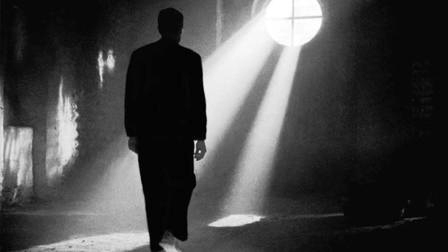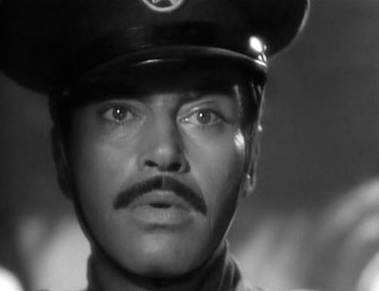|
|
Reviewed by Glenn Erickson
Catholic-themed have presented special problems for critics. When Hitchcock analysts get into discussions of I Confess or The Wrong Man they sometimes miss the point, trying to reconcile the concept of plausibility with what devout Catholics might do in certain situations. I've learned more about a movie like Fred Zinnemann's The Nun's Story talking to non-film people, than I have reading film books. That's not to say that I claim an understanding of the subject, mind you; something like Luis Buñuel's The Milky Way shoots so far over this reviewer's head that viewing it is a healthy, humbling experience.
Filmgoers know Grahame Greene as a writer of thrillers, but on closer inspection even his hard crime stories turn out to have strong Catholic themes. I wasn't following Neil Jordan's 1999 The End of the Affair until my wife explained the concept of self-atonement by 'making a bargain with God'. It's something that traditional Catholics understand.

John Ford's 1947 production The Fugitive is a strange choice of subject matter. Ford was at the time engaged in a string of westerns, but went to Mexico to film this for RKO. Is it possibly Ford's contribution to the wave of anti-Communist films that were just getting traction in Hollywood? The movie takes place in an unnamed South American country where a communist government has outlawed the Catholic Church and has expelled or executed all priests. Star Henry Fonda served as Ford's exponent of the liberal conscience in the pre-war years. The actor plays a Fugitive Priest who cannot help but put his life in danger by performing rites of baptism, etc., for the peasants he meets.
All of the film's characters are given generic identities. Pedro Armendáriz is a Police Lieutenant dedicated to the eradication of Catholic superstition. He's so determined to hunt down the last Priest at large, that he threatens to take and shoot hostages until the man is surrendered to him. Dolores del Rio is an Indian Woman and the mother of the Lieutenant's illegitimate baby. The Lieutenant is pained by this situation but doesn't let it interfere with his anti-church crusade. He treats the Woman badly, for continuing to follow the outlawed religion.
The Fugitive Priest stumbles from one situation to another, and tries to find safety by leaving the country. He's boarding a boat when a boy begs him to stay and give last rites to a dying man. An Indian Informer (J. Carrol Naish) befriends The Fugitive and gives him aid, but waits for the perfect opportunity to turn him in.
Running parallel to The Priest is a wanted criminal called The Gringo (Ward Bond). This American keeps running into wanted posters with his picture on them. He drinks in bars but cannot find a friend. Recognizing The Priest as a fellow man on the run, The Gringo covers for him, drawing off a troop of mounted police by offering himself as a ready target.

By this point a blind man would recognize The Fugitive as a Christ allegory, with The Informer as Judas and The Gringo as Barabbas. Like Jesus, The Fugitive cannot help but face up to his 'destiny' as a martyr. The story also scores points about government corruption when the Police Chief (Leo Carillo) drinks with The Priest one night and the next morning sentences him to prison for possessing alcohol. Yet the Lieutenant is not a hypocrite. His methods are ruthless and cruel, but he truly believes that The Church is an evil institution, and that by suppressing it he's saving his people.
Nobody sees The Fugitive without remarking on its cinematography. Mexican camera artist Gabriel Figueroa's specialty at this time was overloading images with beautiful close-ups and striking symbolic compositions. Figueroa shot many Mexican masterpieces not screened for American audiences, but they did see his work in The Pearl, based on the story by John Steinbeck. At least 40% of the film's shots are highly mannered compositions. With Ford emphasizing Christian iconography (shadows of crosses are everywhere) and making Dolores del Rio glow with 'peasant virtue' like a Mexican Mother of Christ, the film is heavy going, visually. The gaunt, haunted Henry Fonda stumbles from one street corner to the next, looking like the saddest man on. There is no room for interpretation; The Fugitive is a film for believers.

An interesting comparison can be made with Ford's relentless Catholic imagery, and a single scene in an Alfred Hitchcock film. In The Wrong Man, American Catholic Manny Balestrero (Henry Fonda, again) prays to a cross on the wall of his apartment. His face dissolves to a superimposed image of his 'other, guilty' self, the real thief who has wrecked Manny's life. It's a simple image but not a naïve one, as it communicates Hitchcock's theme of the transference of guilt in Catholic terms. The two men look somewhat alike and they've never met. One's crimes have harmed the other, but they share a common humanity and are considered equal under the God to whom Manny prays. Beyond comparing the two men, Hitchcock's visual 'gimmick' says only that the crook is on the prowl at the same time that Manny is praying. We supply the inference that Manny's prayers are being answered. The Wrong Man is about an everyday Catholic family under terrible stress, and Hitchcock has found an expressive way to integrate Manny's faith into the story. In contrast, all the posing and graphic symbolism staged for the camera in The Fugitive seems terribly forced.
The story of The Fugitive might end here, except that readers were appalled to see Graham Greene's novel (which is considered by some to be his masterpiece) turned literally upside down. Greene's original book (titled The Labyrinthine Ways or The Power and The Glory) tells another story altogether. Greene's original Priest is imperfect to say the least. He's corrupt, and a severe alcoholic. He is the father of the Indian Woman's baby, not the Police Lieutenant. These profound character flaws make the Priest a suffering human who is himself bewildered by the nature of his faith, and wracked by guilt. His 'noble' acts may be blind attempts to atone for his sins. He's altogether a much more thoughtful and complex creation. The movie tries to have it both ways. Henry Fonda plays The Fugitive in this guilty, haunted manner, even though the story changes have whitewashed his character. The lush visuals confuse things further by nominating him for instant sainthood.
Anyone aware of the way the Hollywood Production Code monitored filmic depictions of Christianity can rightly argue that John Ford could never have made a faithful adaptation of the Graham Greene novel. John Ford's film is a heartfelt, simplified, and safe fairy tale versiony. When Greene heard about the changes that had been made, he decided never to see the film. The original story was later adapted twice for Television plays, that starred James Donald and Laurence Olivier. Critics and the public were shocked to find out what the character was really meant to be.
Graham Greene's book was written specifically about Mexico. A political period called The Maximato (1928-1934) saw the country under the strongly leftist, virulently anti-Church government of Plutarco Elías Calles, the successor to Álvaro Obregón. The conditions shown in The Fugitive follow exactly what took place in a couple of remote Mexican states. The film's stars, landscape, buildings, costumes, military uniforms and music are all distinctly Mexican, yet the film begins with a narration that identifies the story as "somewhere or nowhere" in Latin America. Movies made in Mexico, even those by outsiders, must have been subject to official script approval. This is why Luis Buñuel's "political" adventures like Death in the Garden are all meant to take place in other (usually unnamed) countries. It's also why the Gary Cooper movie Blowing Wild, in which stereotyped Mexican banditos raid oil wells, begins with a laughable title card reading, "South America."
I would guess that Mexico didn't want its history revisited in a questionable light. A powerful center-right political party was in power, but the same forces that drove the revolutions and civil wars were still about. Leon Trotsky, after all, had been assassinated in Mexico City just seven years before.

The fine actress Dolores del Rio works hard looking beatific and pure. Just remember that about fifteen years before she also played a joyful half-naked South Seas temptress, in the very sensual Bird of Paradise. Pedro Armendáriz is marvelous as the draconian pursuer, a true believer of a different kind. The talented 'ethnic chameleon' J. Carrol Naish steals every scene he's in, while Leo Carrillo (the sidekick Pancho to TV's The Cisco Kid) is suitably decadent as the lazy Police Chief. Ford regulars Robert Armstrong, John Qualen and Chris-Pin Martin are also on view, while Mel Ferrer makews his first screen appearance in a tiny bit, as another priest. Coming off extremely well is Ward Bond, whose "Gringo" character was greatly enlarged and romanticized for the screen adaptation. Bond doesn't talk much or even act like an Ugly American, but he provides the film's only moments of conventional action and jeopardy. I would imagine Graham Greene would have been appalled.
With the Mexican cast and cinematographer on board, it looks as if a number of the top technical positions were duplicated with Mexican personnel that may or may not have been redundant. A union-dictated 'adjunct director' was also required, and the powerful top Mexican director Emilio Fernández served that function. It is said that twelve years later on The Magnificent Seven "El Indio" gave advice on costumes and other details. It's possible that on The Fugitive he acted as more of an assistant director. Fernández' own melodramas are packed with the kind of reverent imagery seen here, so we wonder if Ford may have delegated much of the film's look to him and Figueroa.
John Ford produced The Fugitive with his Argosy Pictures partner Merian C. Cooper; at the time they surely had a cavalry picture in the works, as well as their King Kong followup, Mighty Joe Young.

The Warner Archive Collection DVD-R of The Fugitive is taken from a good if not terrific source element, that should be stressed is much better than any copy I've yet seen. TV prints were rather dark and dank, and here we can see everything. It's dirty in spots and a bit worn, but quite good overall. The film is a good candidate for the WAC -- it earned next to nothing on release and has not exactly been a heavily requested title for Ford retrospectives. I remember going to (I think) the County Museum of Art to see it screened. After the co-feature (The Informer?) played, you'd have thought someone had announced an air raid. 300 people disappeared and I watched it in an almost empty theater. Thirty years later, audiences are much more interested in John Ford's one Mexican movie.
On a scale of Excellent, Good, Fair, and Poor,
The Fugitive rates:
Movie: Good
Video: Good +/-
Sound: Good
Subtitles: None
Supplements: none
Packaging: Keep case
Reviewed: September 21, 2013

DVD Savant Text © Copyright 2013 Glenn Erickson
See more exclusive reviews on the Savant Main Page.
Reviews on the Savant main site have additional credits information and are often updated and annotated with reader input and graphics.
Also, don't forget the
2011 Savant Wish List.
T'was Ever Thus.
Return to Top of Page
|

